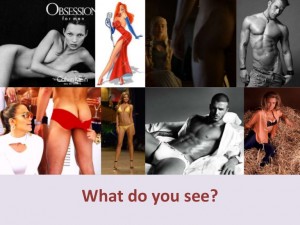Can “gender in the gaze” be equated to objectification?
The image of women in media has largely been produced into a what most men would find desirable: skinny, yet with curves all over. Therefore, what has been created for men is a desire for something almost impossible and unattainable, and for women a pressure to become what is desired. Through the specific presentation and placement of women in media as filtered through the gendered or male gaze, women have become a thing and object rather than a person. And now, what has resulted is a battle for freedom from objectification within a woman’s self.
However, this battle has been happening for centuries. As explained by Sturken and Cartwright, there has been a tradition of the nude in painting to present the nude women to male viewers (124). Throughout history, we see paintings and artworks with the code “of imaging the female nude,” and has long been established as a norm in society. The reading explains how the viewer sees the work and the women may either interact with the viewer or have a passive look. To explain, the instance where the viewer is met with the eyes of the woman depicted gives a sense of scopohilia- the pleasure in looking and exhibitionism. This sense of scopophilia translates the look of the woman towards the viewer as one of sexual desire and pleasure at being looked at- as if the woman is saying, “keep looking at me.” This brings all the attention to the woman and distracts from the rest of the image.
Here, the women look directly at the viewer in a seducing manner to bring the attention directly to them. And forget about the beer, these women HAVE become the beer, and the male gaze makes these women objects of desire which further plays into the idea of scopophilia.
The second manner women become objects through the male gaze is by means of their depiction as passive objects. As seen in many forms of media, women are often times depicted as candid or passive objects by having them look off away from the direct gaze of the viewer. Through this presentation of women, the male gaze takes on a new aspect: Voyeurism. As explained by the reading, voyeurism is the pleasure one takes in looking while not being seen looking. Therefore, when the women depicted do not look at the viewer, the viewer’s gaze is made more powerful as it brings an almost sadistic aspect to the gaze (124).
The gendered or male gaze has long been used in the presentation and depiction of women in media. Through the gaze, women have battled with this objectification that has developed from what has historically been accepted as the norm as seen in various works of art. Although this idea is nothing new, it has been amplified into something greater with the passing of time. Today, we see women and their bodies being used more and more as objects of pleasure and desire, but this has served to distort reality and what is actuality. And I talk about this in terms of the female body because of its historical prevalence in culture, but this idea does not solely stay within the realm of women objectification. The male body has also suffered objectification as a form of sexual desire and unattainable reality. However, this is not a matter of who gets it worse, but rather, why is this gaze and presentation of bodies still used in the first place?

